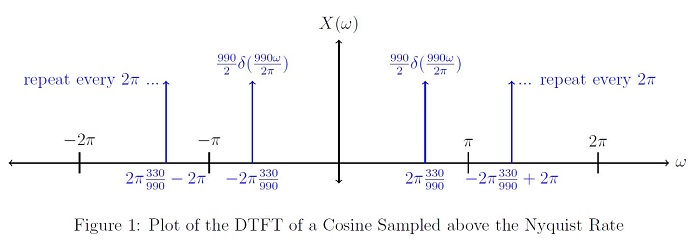| Line 30: | Line 30: | ||
== Useful Background == | == Useful Background == | ||
| − | Nyquist Condition: < | + | Nyquist Condition: <math>f_s = 2f_{max}</math></font> |
| + | DTFT of a Cosine: <font size="2"><math>x_d[n] = cos(2\pi nT){\leftrightarrow}X(\omega) = \pi(\delta(\omega-\omega_o) + \delta(\omega+\omega_o)){ ,for\ } \omega \in [-\pi,\pi]</math></font> | ||
<font size="2">The DTFT of a sampled signal is periodic with <span class="texhtml">2π</span>.</font> | <font size="2">The DTFT of a sampled signal is periodic with <span class="texhtml">2π</span>.</font> | ||
| Line 55: | Line 56: | ||
</math> | </math> | ||
| + | [[Image:AboveNyquist.jpg]] | ||
Revision as of 07:30, 2 October 2014
DTFT of a Cosine Sampled Above and Below the Nyquist Rate
A slecture by ECE student Sahil Sanghani
Partly based on the ECE438 Fall 2014 lecture material of Prof. Mireille Boutin.
Contents
Outline
- Introduction
- Useful Background
- DTFT Example of a Cosine Sampled Above the Nyquist Rate
- DTFT Example of a Cosine Sampled Below the Nyquist Rate
- Conclusion
- References
Introduction
In this Slecture, I will walk you through taking the DTFT of a pure frequency sampled above and below the Nyquist Rate. Then I will compare the differences between them.
Useful Background
Nyquist Condition: $ f_s = 2f_{max} $</font> DTFT of a Cosine: $ x_d[n] = cos(2\pi nT){\leftrightarrow}X(\omega) = \pi(\delta(\omega-\omega_o) + \delta(\omega+\omega_o)){ ,for\ } \omega \in [-\pi,\pi] $
The DTFT of a sampled signal is periodic with 2π.
DTFT of a Cosine Sampled Above the Nyquist Rate
For our original pure frequency, let’s choose the E below middle C. The E occurs at 330Hz x(t) = cos(2π * 330t) <p>Now let’s sample this pure cosine at a frequency above the Nyquist Rate. The Nyquist Rate is:
fs = 2 * fm'a'x = 2 * (330H'z) = 660H'z.
Let’s sample at 990H'z.
$ \begin{align} \\ x_d[n] & = x(n*\frac{1}{990Hz})\\ & = cos(2\pi n *\frac{330}{990}) = \frac{e^{j2\pi n \frac{330}{550}} + e^{-j2\pi n \frac{330}{550}}}{2}\\ & = cos(\frac{2\pi n}{3}) \end{align} $
Because $ \left | \frac{2\pi}{3}\right | < \pi $, there is no aliasing occurring in the DTFT, and it can be written as follows:
$ \begin{align} \\ X(\omega) & = \frac{1}{2}(2\pi\delta(\omega - 2\pi \frac{330}{990}) + 2\pi\delta(\omega + 2\pi \frac{330}{990})) , \ \omega \in\ [-\pi,\pi]\\ & = \frac{990}{2}(\delta(\frac{990}{2\pi}\omega - 330) + \delta(\frac{990}{2\pi}\omega + 330)) , \ \omega \in\ [-\pi,\pi]\\ & = rep_{2\pi}(\frac{990}{2}(\delta(\frac{990}{2\pi}\omega - 330) + \delta(\frac{990}{2\pi}\omega + 330))), \forall \omega \end{align} $


